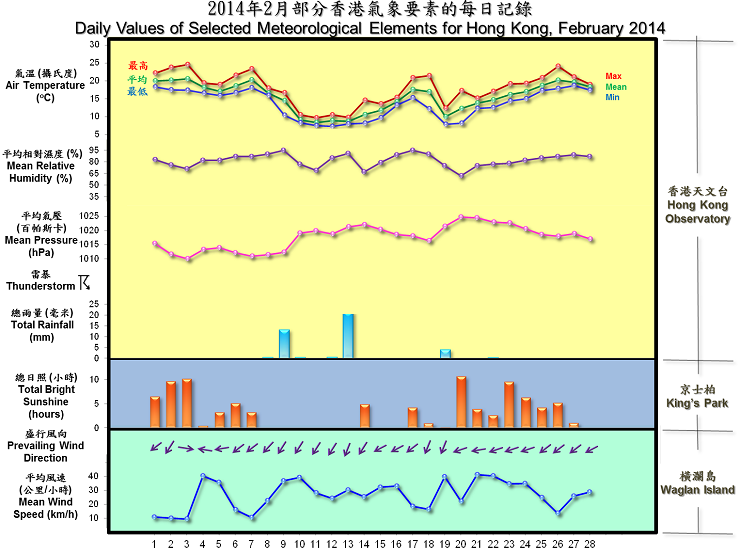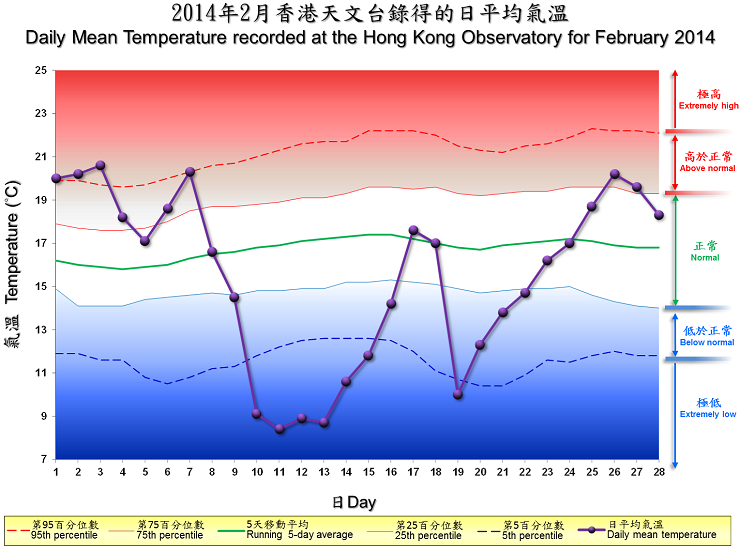The Weather of February 2014
|
With several rounds of transition between warm and cold air masses along the coast of Guangdong, the weather of Hong Kong in February 2014 was marked by fluctuating temperatures. The mild episodes in the first and last weeks of the month contrasted sharply against the chilly weather that prevailed in mid-February. On the whole, February 2014 was cooler than usual with a monthly mean temperature of 15.5 degrees, 1.3 degrees below the normal figure of 16.8 degrees. February 2014 was also drier than normal. The monthly rainfall of 39.5 millimetres was about 27 percent below the normal figure of 54.4 millimetres. Without any measurable rainfall in January 2014, the accumulated rainfall of 39.5 millimetres in the first two months of the year was only about half of the normal figure of 78.9 millimetres for the same period. |
|
Two tropical cyclones occurred over the South China Sea and the western North Pacific in the month. |
|
Details of issuance and cancellation of various warnings/signals in the month are summarized in Tables 1.1 to 1.3. Monthly meteorological figures and departures from normal for February are tabulated in Table 2. |
Warnings and Signals issued in February 2014
| Beginning Time | Ending Time | ||
|---|---|---|---|
| Day/Month | HKT | Day/Month | HKT |
| 10 / 2 | 0015 | 10 / 2 | 1040 |
| 18 / 2 | 1620 | 19 / 2 | 1945 |
| 28 / 2 | 0840 | 28 / 2 | 1615 |
| Colour | Beginning Time | Ending Time | ||
|---|---|---|---|---|
| Day/Month | HKT | Day/Month | HKT | |
| Yellow | 1 / 2 | 1200 | 1 / 2 | 2045 |
| Yellow | 2 / 2 | 0600 | 3 / 2 | 2400 |
| Yellow | 14 / 2 | 1200 | 14 / 2 | 2300 |
| Yellow | 20 / 2 | 0600 | 20 / 2 | 2245 |
| Yellow | 23 / 2 | 1145 | 23 / 2 | 2100 |
| Beginning Time | Ending Time | ||
|---|---|---|---|
| Day/Month | HKT | Day/Month | HKT |
| 9 / 2 | 0745 | 16 / 2 | 1015 |
| 18 / 2 | 1145 | 21 / 2 | 1130 |
| Meteorological Element | Figure of the Month | Departure from Normal* |
|---|---|---|
| Mean Daily Maximum Air Temperature | 17.9 degrees C | 1.0 degree below normal |
| Mean Air Temperature | 15.5 degrees C | 1.3 degrees below normal |
| Mean Daily Minimum Air Temperature | 13.5 degrees C | 1.5 degrees below normal |
| Mean Dew Point Temperature | 12.3 degrees C | 0.7 degree below normal |
| Mean Relative Humidity | 82 % | 2 % above normal |
| Mean Cloud Amount | 73 % | 1 % below normal |
| Total Rainfall | 39.5 mm | 14.9 mm below normal |
| Number of hours of Reduced VisibilityΔ | 58 hours | 81.2 hours below normal§ |
| Total Bright Sunshine Duration | 91.9 hours | 2.3 hours below normal |
| Mean Daily Global Solar Radiation | 10.08 Megajoule / square metre | 0.69 Megajoule above normal |
| Total Evaporation | 59.8 mm | 0.1 mm below normal |
| Remarks : | All measurements were made at the Hong Kong Observatory except sunshine, solar radiation and evaporation which were recorded at King's Park Meteorological Station and visibility which was observed at the Hong Kong International Airport. |
| Δ |
The visibility readings at the Hong Kong International Airport are based on hourly observations by professional meteorological observers in 2004 and before, and average readings over the 10-minute period before the clock hour of the visibility meter near the middle of the south runway from 2005 onwards. The change of the data source in 2005 is an improvement of the visibility assessment using instrumented observations following the international trend. |
* Departure from 1981 - 2010 climatological normal, except for number of hours of reduced visibility |
|
§ Departure from mean value between 1997 and 2013 |
|


| Remarks : | Extremely high: above 95th percentile Above normal: between 75th and 95th percentile Normal: between 25th and 75th percentile Below normal: between 5th and 25th percentile Extremely low: below 5th percentile Percentile and 5-day running average values are computed based on the data from 1981 to 2010 |
